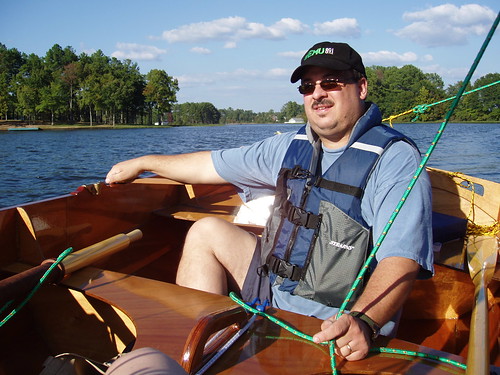Oars and ends

Today was a hodgepodge of activities. I began the morning lacing the leathers on the new oars I received recently. The lacing process was made more difficult by very confusing directions that came with the oar leather "kit". For instance, measuring distances from the "top" of the oar begs the question, "Which end is the top?" It is also unhelpful to say the seam should lie "parallel" to the blade, since a seam in any position around the 360 degrees of the loom (or shaft) of the oar could be said to be parallel. But finally, after cutting the leather to size, meticulously marking and punching holes, and laboriously stitching the leather around the oar, I was satisfied with the result. After about two hour work (which I won't count against the boat building total) I completed one oar.
I then went outside to enjoy another sunny warm midwinter day. Today's task was to trim the strakes at each transom. With careful use of a Japanese (flush cut) saw, and a belt sander with 80-grit paper, the strake overhangs were brought flush with the transoms. Further sanding with 120-grit paper in an orbital palm sander finished the ends nicely. There are a couple of small gaps between the strakes and the transoms that will need to be filled in with thickened epoxy. But all is ready for the next step; the glassing of the interior. Total hours 41.00.


1 Comments:
It looks good sir.
You mentioned in your email to me that you're a little concerned about how the glass will lay down on curved surfaces. My experience (limited as it is with highly curved surfaces) is that you'll have no problems. However, if your test lay shows you a lot of wrinkles, you could do relief cuts in the fiberglass before you wet it with epoxy. The biggest thing is to make sure that you have some overlap at each fiberglass joint... this will help you attain maximum strength.
Also, we pre-wet the wood before laying the glass. We do this to ensure that the wood doesn't wick any of the epoxy away from the fiberglass, leaving areas starved of epoxy.
We lay the cloth and trim to size, roll it up and pre-epoxy the area we're glassing, then lay the cloth on top of the wetted area, and add more epoxy as needed. This process has worked well on both this project and the canoes we made about two years ago. This method works better if you have two people available to stretch, lay and smooth the cloth as needed. If you're truly doing this solo, sticking with your method won't hurt.
Post a Comment
<< Home